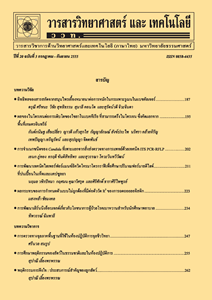การสังเคราะห์อนุภาคนาโนทองคำโดยใช้เซรัมที่เตรียมจากหางน้ำยางธรรมชาติ : ผลของสารจับก้อนยางที่เหลือ
Main Article Content
Abstract
This research proposed the use of the serum from the skim natural rubber latex (SNRL), the waste from the concentrated latex production, as a source of reducing and stabilizing agents in a green synthesis of gold nanoparticles (AuNPs). The coagulants including H2SO4, CH3COOH, and cationic polyacrylamide (PAM) solutions were used to remove rubber particles and the serums with remaining coagulants were obtained. The serum was diluted with water for various dilution factors and then mixed with gold (III) chloride trihydrate (HAuCl4.3H2O). The results showed that the serum with remaining H2SO4 gave large particles, while the serums with both CH3COOH and PAM could stabilize and yield AuNPs, of which the characteristic absorbance peaks around 530 nm were observed. However, regarding the degree of colloidal stability when the reaction was prolonged, the serum with PAM was superior. Dilution of the serum was found necessary since the reaction could be controlled when the concentrations of both reducing and stabilizing agents were not too high. Figures from Transmission Electron Microscope (TEM) confirmed that using the serum with PAM, the AuNPs were synthesized and had the size ranged from 5-45 nm or the average diameter of 23±2 nm.
Article Details
References
[2] Bartosewicz, B., Bujno, K., Liszewska, M., Budner, B., Bazarnik, P., Płocińskib, T. and Jankiewicz, J.J., 2018, Effect of citrate substitution by various α-hydroxy carboxylate anions on properties of gold nanoparticles synthesized by Turkevich method, Colloids Surf. A 549: 25-33.
[3] Hormozi-Nezhad, M.R., Seyedhosseini, E. and Robatjazi, H., 2012, Spectrophotome tric determination of glutathione and cysteine based on aggregation of colloidal gold nanoparticles, Sci. Iranica F 19: 958-963.
[4] Priyadarshinia, E. and Pradhan, N., 2017, Gold nanoparticles as efficient sensors in colorimetric detection of toxic metal ions: A review, Sensor. Actuator. B 238: 888-902.
[5] Wei, X., Wang, Y., Zhao, Y. and Chen, Z., 2017, Colorimetric sensor array for protein discrimination based on different DNA chain length-dependent gold nano particles aggregation, Biosens. Bioelectron. 97: 332-337.
[6] Rad, A.G., Abbasi, H. and Afzali, M.H., 2011, Gold nanoparticles: Synthesizing, charac terizing and reviewing novel application in recent years, Phys. Proc. 22: 203-208.
[7] Yuan, C.G., Huo, C., Yu, S. and Gui, B., 2017, Biosynthesis of gold nanoparticles using Capsicum annuum var. grossum pulp extract and its catalytic activity, Phys. E 85: 19-26.
[8] Hoshyar, R., Khayati, G.R., Poorgholami M. and Kaykhaii, M., 2016, A novel green one-step synthesis of gold nanoparticles using crocin and their anti-cancer activities, J. Photochem. Photobiol. B Biol. 159: 237-242.
[9] Kumar, C.G., Poornachandra, Y. and Mamidyala, S.K., 2014, Green synthesis of bacterial gold nanoparticles conjugated toresveratrol as delivery vehicles, Colloids Surf. B Biointerfaces 123: 311-317.
[10] Pandey, S., Goswami, K.G. and Nanda K.K., 2013, Green synthesis of polysaccha ride/gold nanoparticle nanocomposite: An efficient ammonia sensor, Carbohyd. Polym. 94: 229-234.
[11] Patra, J.K., Kwon, Y. and Baek, K.H., 2016, Green biosynthesis of gold nanoparticles by onion peel extract: Synthesis, characterization and biological activities, Adv. Powder Technol. 27: 2204-2213.
[12] Santhoshkumar, J., Rajeshkumar, S. and Kumar, S.V., 2017, Phyto-assisted synthesis, characterization and applications of gold nanoparticles: A review, Biochem. Biophys. Rep. 11: 46-57.
[13] Sun, L., Li, J., Cai, J., Zhong, L., Ren, G. and Ma Q., 2017, One pot synthesis of gold nanoparticles using chitosan with varying degree of deacetylation and molecular weight, Carbohyd. Polym. 178: 105-114.
[14] Yan, W., Chena, C., Wang, L., Zhang, D., Li, A.J., Yao, Z. and Shi L.Y., 2016, Facile and green synthesis of cellulose nanocrystal-supported gold nanoparticles with superior catalytic activity, Carbohyd. Polym. 140: 66-73.
[15] Entrya, J.A., Sojka, R.E., Watwood, M. and Ross, C., 2002, Polyacrylamide preparations for protection of water quality threatened by agricultural runoff contaminants, Environ. Pollut. 120: 191-200.
[16] Ma, J., Fu, K., Jiang, L., Ding, L., Guan, Q., Zhang, S., Zhang, H., Shi, J., Fu, X., 2017, Flocculation performance of cationic polyacrylamide with high cationic degree in humic acid synthetic water treatment and effect of kaolin particles, Sep. Purif. Technol. 181: 201-212.
[17] Zhao, C., Zheng, H., Gaoc, B., Liu, Y., Zhai, J., Zhang, S. and Xu, B., 2018, Ultrasound-initiated synthesis of cationic polyacrylamide for oily wastewater treatment: Enhanced interaction between the flocculants and contaminants, Ultrason. Sonochem. 42: 31-41.
[18] Sakdapipanich, J., 2010, Natural Rubber Technology, TechnoBiz Communications Co., Ltd., Bangkok. (in Thai)
[19] Khajornchaikool, W., 2006, Natural Rubber: Production and Applications, The Thailand Research Fund (TRF), Bangkok, 38 p. (in Thai)


